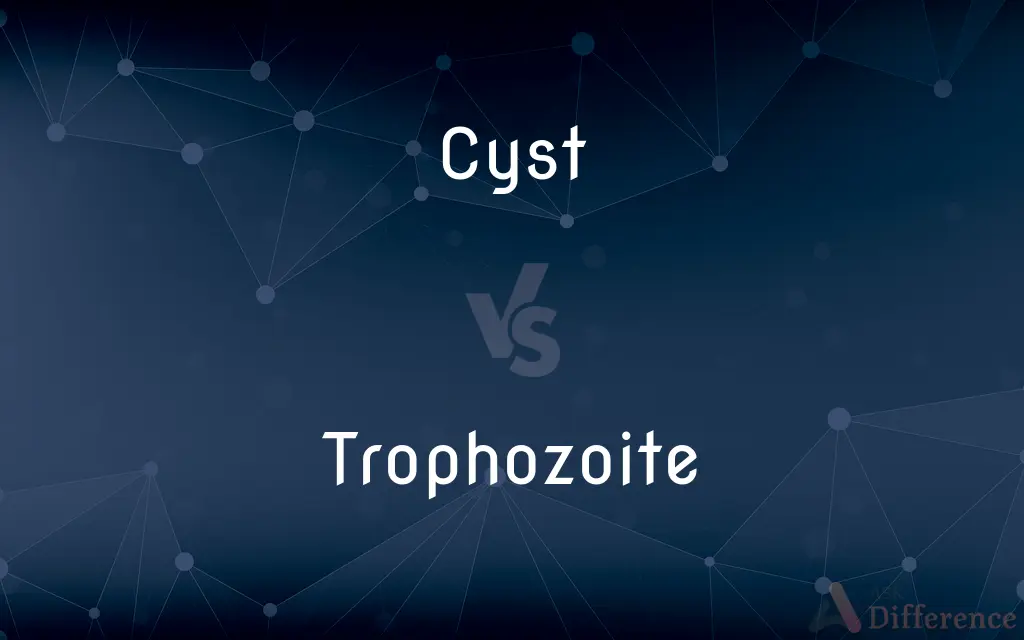Cyst vs. Trophozoite — What's the Difference?
By Tayyaba Rehman — Updated on September 21, 2023
Cyst is a protective, dormant form of some protozoa, on the other hand, trophozoite is the active, feeding stage of certain protozoa.

Difference Between Cyst and Trophozoite
Table of Contents
ADVERTISEMENT
Key Differences
Cyst and Trophozoite are terms primarily related to the life cycle stages of certain protozoans. A cyst is a hardy, dormant form, while a trophozoite is the active, feeding phase.
When conditions are harsh, many protozoa convert into cysts, which are protected by a thick wall. Trophozoites, on the other hand, are typically found in more favorable environments where they feed and multiply.
The cyst form is resistant to environmental stresses, ensuring the survival of the organism in less than ideal conditions. The trophozoite phase, being active, is more sensitive to external conditions.
For medical professionals, distinguishing between cysts and trophozoites is crucial. Cysts often facilitate transmission of diseases, while trophozoites are usually responsible for the symptoms.
In summary, the cyst is a survival mechanism for certain protozoa, while the trophozoite represents the organism's active state of growth and feeding.
ADVERTISEMENT
Comparison Chart
Function
Survival in unfavorable conditions.
Growth, multiplication, and feeding.
Activity Level
Dormant.
Active.
Sensitivity to External Conditions
Resistant due to protective wall.
Sensitive.
Role in Disease Transmission
Often responsible for transmission.
Causes symptoms of diseases.
Structure
Enclosed in a protective wall.
Lacks protective wall, more vulnerable.
Compare with Definitions
Cyst
A sac filled with liquid or semi-solid material.
She went to the doctor to get a cyst on her back checked.
Trophozoite
The active, feeding stage of certain protozoa.
The trophozoite phase of the parasite causes the symptoms of the disease.
Cyst
An abnormal growth containing fluid.
The ultrasound revealed a cyst on her ovary.
Trophozoite
A phase of certain microorganisms characterized by growth and feeding.
The water sample had a high concentration of trophozoites.
Cyst
A closed pocket or pouch of tissue.
He had a benign cyst removed from his neck.
Trophozoite
A mobile stage in the life cycle of some sporozoan parasites.
In the intestine, the ingested cysts convert to trophozoites.
Cyst
A stage in the life cycle of certain organisms, characterized by a thick wall.
The organism forms a cyst to survive harsh conditions.
Trophozoite
The vegetative form of a protozoan, as opposed to its reproductive or cyst form.
Trophozoites thrive in favorable conditions.
Cyst
A protective, dormant form of certain protozoa.
Waterborne diseases can be spread through the ingestion of cysts.
Trophozoite
An active form of a parasite that absorbs nutrients from its host.
The patient's symptoms were due to the presence of trophozoites.
Cyst
A cyst is a closed sac, having a distinct envelope and division compared with the nearby tissue. Hence, it is a cluster of cells that have grouped together to form a sac (like the manner in which water molecules group together to form a bubble); however, the distinguishing aspect of a cyst is that the cells forming the "shell" of such a sac are distinctly abnormal (in both appearance and behaviour) when compared with all surrounding cells for that given location.
Trophozoite
A trophozoite (G. trope, nourishment + zoon, animal) is the activated, feeding stage in the life cycle of certain protozoa such as malaria-causing Plasmodium falciparum and those of the Giardia group. (The complement of the trophozoite state is the thick-walled cyst form).
Cyst
An abnormal membranous sac in the body containing a gaseous, liquid, or semisolid substance.
Trophozoite
An elongated cell that develops from a sporozoite or a merozoite of an apicomplexan parasite and that feeds and grows within the host.
Cyst
A sac or vesicle in the body.
Trophozoite
A protozoan in the feeding stage of its life cycle.
Cyst
(Biology) A small capsulelike sac that encloses certain organisms in their dormant or larval stage.
Trophozoite
A sporozoan in the active feeding stage of its life cycle
Cyst
(Botany) A thick-walled resting spore, as in certain algae or fungi.
Cyst
A pouch or sac without opening, usually membranous and containing morbid matter, which develops in one of the natural cavities or in the substance of an organ.
Cyst
(medicine) Of or pertaining to the urinary bladder or gall bladder (in compounds).
Cystectomy, cystitis, cystoscopy
Cyst
A pouch or sac without opening, usually membranous and containing morbid matter, which is accidentally developed in one of the natural cavities or in the substance of an organ.
Cyst
One of the bladders or air vessels of certain algæ, as of the great kelp of the Pacific, and common rockweeds (Fuci) of our shores.
Cyst
A small capsule or sac of the kind in which many immature entozoans exist in the tissues of living animals; also, a similar form in Rotifera, etc.
Cyst
A closed sac that develops abnormally in some body structure
Cyst
A small anatomically normal sac or bladderlike structure (especially one containing fluid)
Common Curiosities
What is a Cyst?
A cyst is a protective, dormant form of certain protozoa or a sac filled with liquid or semi-solid material.
What is a Trophozoite?
A trophozoite is the active, feeding stage of certain protozoa.
What role does a Cyst play in protozoa?
Cysts allow protozoa to survive in harsh conditions by becoming dormant and resistant.
Are all cysts related to diseases?
No, many cysts are benign growths, but some can transmit diseases.
How do Trophozoites relate to diseases?
Trophozoites are usually responsible for the symptoms of diseases caused by protozoa.
Why is it important to differentiate between Cyst and Trophozoite in a clinical setting?
Distinguishing them helps in understanding disease transmission and manifestation.
Can Cysts revert to Trophozoites?
Yes, in favorable conditions, cysts can convert back to trophozoites.
Are Cysts exclusive to protozoa?
No, the term "cyst" can also refer to sac-like growths in the body.
What triggers the conversion of Trophozoite to Cyst?
Harsh environmental conditions typically trigger this conversion.
Is the Trophozoite stage longer than the Cyst stage?
It varies by species, but trophozoites prevail in favorable conditions.
Can you see a Cyst or Trophozoite with the naked eye?
Typically no, they are microscopic.
Which is more resistant, Cyst or Trophozoite?
Cysts are more resistant due to their protective walls.
Are Trophozoites always harmful?
Not always. Only certain species cause diseases in humans.
Can one organism have both Cyst and Trophozoite stages?
Yes, these stages are part of some organisms' life cycles.
How are Cysts typically transmitted?
Often through contaminated water or food.
Share Your Discovery

Previous Comparison
Groove vs. Ridge
Next Comparison
CEO vs. OwnerAuthor Spotlight
Written by
Tayyaba RehmanTayyaba Rehman is a distinguished writer, currently serving as a primary contributor to askdifference.com. As a researcher in semantics and etymology, Tayyaba's passion for the complexity of languages and their distinctions has found a perfect home on the platform. Tayyaba delves into the intricacies of language, distinguishing between commonly confused words and phrases, thereby providing clarity for readers worldwide.














































